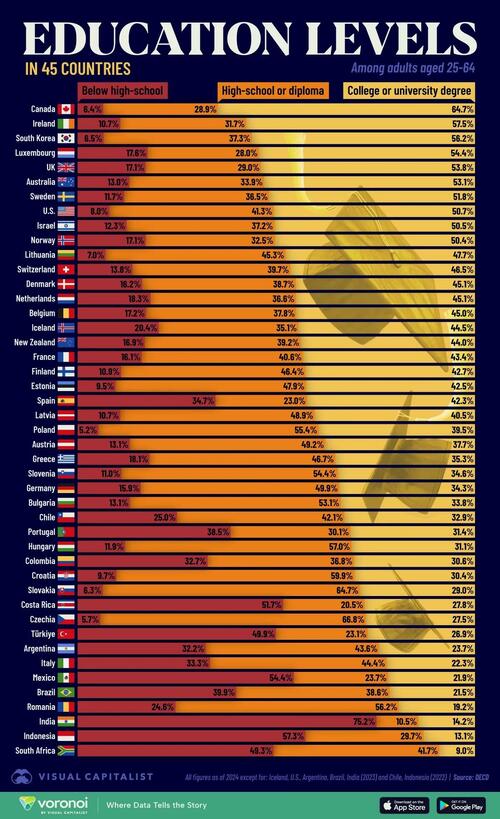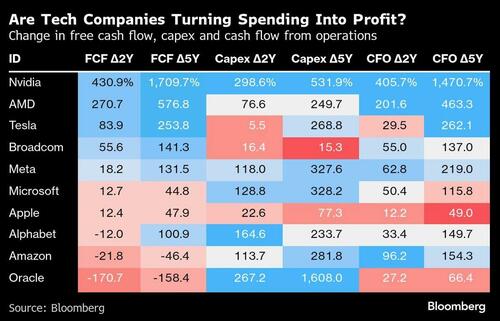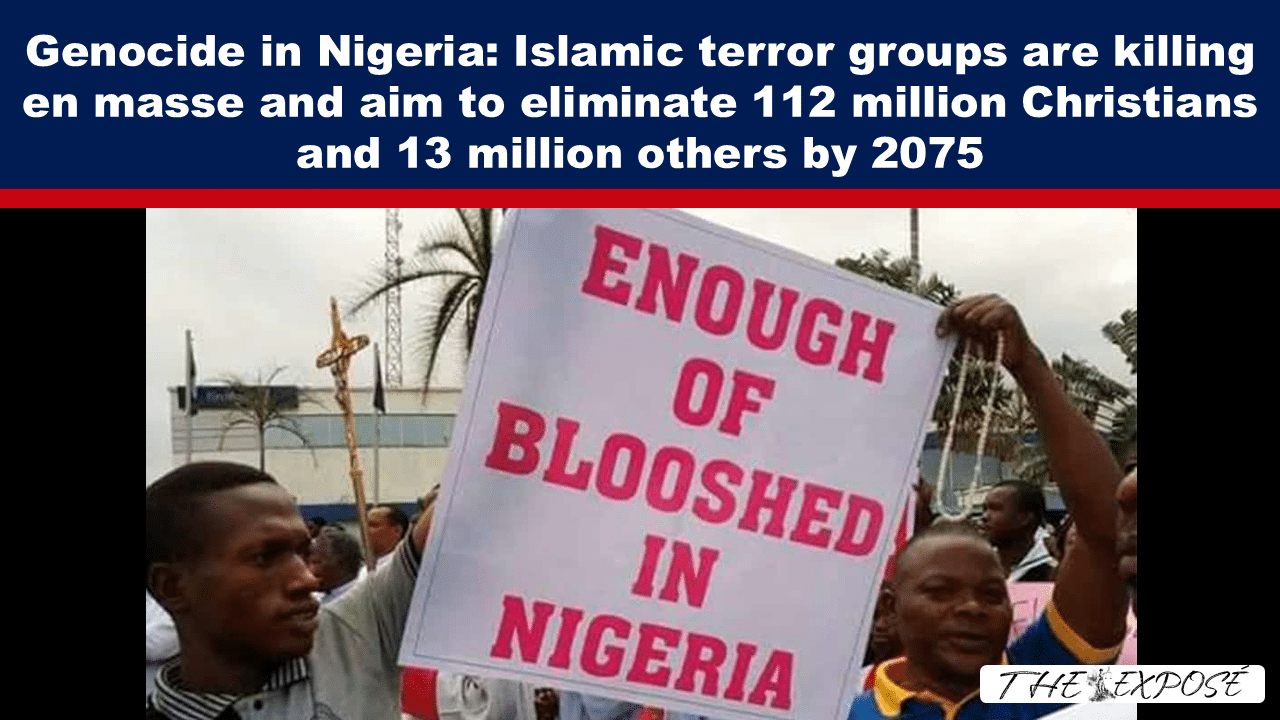These Are The World’s Most Educated Populations

Which countries have the most educated populations?
Higher levels of tertiary education among a populace generally indicate greater potential for innovation and economic growth, but this isn’t always the case.
In this graphic, Visual Capitalist’s Marcus Lu visualizes educational attainment by country, breaking things down into three categories: below high-school, high-school or diploma, and college or university degree.
Data & Discussion
This data comes from the OECD’s Education at a Glance 2025 report. It compares educational attainment among working-age adults across 45 countries as of 2024.
| Country | Below high-school (%) |
High-school or diploma (%) |
College or university degree (%) |
|---|---|---|---|
| 🇨🇦 Canada | 6.4 | 28.9 | 64.7 |
| 🇮🇪 Ireland | 10.7 | 31.7 | 57.5 |
| 🇰🇷 South Korea | 6.5 | 37.3 | 56.2 |
| 🇱🇺 Luxembourg | 17.6 | 28.0 | 54.4 |
| 🇬🇧 UK | 17.1 | 29.0 | 53.8 |
| 🇦🇺 Australia | 13.0 | 33.9 | 53.1 |
| 🇸🇪 Sweden | 11.7 | 36.5 | 51.8 |
| 🇺🇸 U.S. | 8.0 | 41.3 | 50.7 |
| 🇮🇱 Israel | 12.3 | 37.2 | 50.5 |
| 🇳🇴 Norway | 17.1 | 32.5 | 50.4 |
| 🇱🇹 Lithuania | 7.0 | 45.3 | 47.7 |
| 🇨🇭 Switzerland | 13.8 | 39.7 | 46.5 |
| 🇩🇰 Denmark | 16.2 | 38.7 | 45.1 |
| 🇳🇱 Netherlands | 18.3 | 36.6 | 45.1 |
| 🇧🇪 Belgium | 17.2 | 37.8 | 45.0 |
| 🇮🇸 Iceland | 20.4 | 35.1 | 44.5 |
| 🇳🇿 New Zealand | 16.9 | 39.2 | 44.0 |
| 🇫🇷 France | 16.1 | 40.6 | 43.4 |
| 🇫🇮 Finland | 10.9 | 46.4 | 42.7 |
| 🇪🇪 Estonia | 9.5 | 47.9 | 42.5 |
| 🇪🇸 Spain | 34.7 | 23.0 | 42.3 |
| 🇱🇻 Latvia | 10.7 | 48.9 | 40.5 |
| 🇵🇱 Poland | 5.2 | 55.4 | 39.5 |
| 🇦🇹 Austria | 13.1 | 49.2 | 37.7 |
| 🇬🇷 Greece | 18.1 | 46.7 | 35.3 |
| 🇸🇮 Slovenia | 11.0 | 54.4 | 34.6 |
| 🇩🇪 Germany | 15.9 | 49.9 | 34.3 |
| 🇧🇬 Bulgaria | 13.1 | 53.1 | 33.8 |
| 🇨🇱 Chile | 25.0 | 42.1 | 32.9 |
| 🇵🇹 Portugal | 38.5 | 30.1 | 31.4 |
| 🇭🇺 Hungary | 11.9 | 57.0 | 31.1 |
| 🇨🇴 Colombia | 32.7 | 36.8 | 30.6 |
| 🇭🇷 Croatia | 9.7 | 59.9 | 30.4 |
| 🇸🇰 Slovak Republic | 6.3 | 64.7 | 29.0 |
| 🇨🇷 Costa Rica | 51.7 | 20.5 | 27.8 |
| 🇨🇿 Czechia | 5.7 | 66.8 | 27.5 |
| 🇹🇷 Türkiye | 49.9 | 23.1 | 26.9 |
| 🇦🇷 Argentina | 32.2 | 43.6 | 23.7 |
| 🇮🇹 Italy | 33.3 | 44.4 | 22.3 |
| 🇲🇽 Mexico | 54.4 | 23.7 | 21.9 |
| 🇧🇷 Brazil | 39.9 | 38.6 | 21.5 |
| 🇷🇴 Romania | 24.6 | 56.2 | 19.2 |
| 🇮🇳 India | 75.2 | 10.5 | 14.2 |
| 🇮🇩 Indonesia | 57.3 | 29.7 | 13.1 |
| 🇿🇦 South Africa | 49.3 | 41.7 | 9.0 |
Leaders in Higher Education
Canada tops the list with nearly 65% of adults holding a college or university degree, followed closely by Ireland and South Korea.
These nations have invested heavily in expanding access to higher education, driven by knowledge-based economies that reward advanced qualifications.
According to other OECD data, higher levels of education bring significant earnings advantages.
For instance, across OECD nations, tertiary graduates typically earn double the income of individuals who have not completed secondary education (high school).
Balanced Education Models in Europe
Countries like Austria and Germany demonstrate a more balanced split between tertiary and vocational education (education related to a specific job or trade).
For example, Germany ranks 19th in the world in terms of GDP per capita, despite only 34% of its adults having a university degree.
The country has a strong apprenticeship system where students combine hands-on training with theoretical learning, resulting in a high rate of employment upon graduation.
If you enjoyed today’s post, check out The Universities Producing the Most Billionaires on Voronoi, the new app from Visual Capitalist.
Loading recommendations…
Recent Top Stories
Sorry, we couldn't find any posts. Please try a different search.











